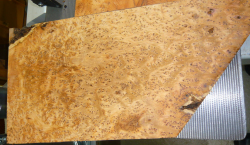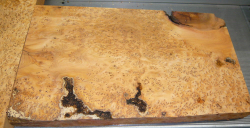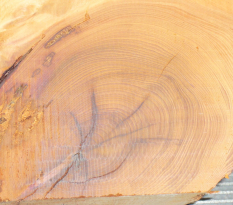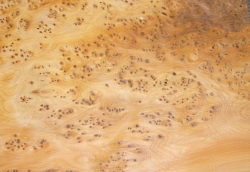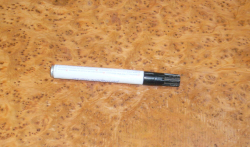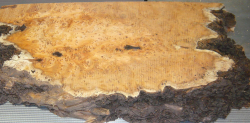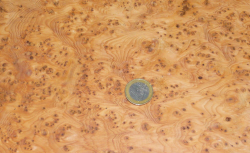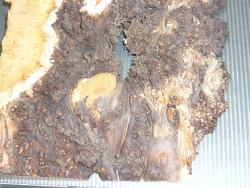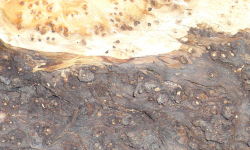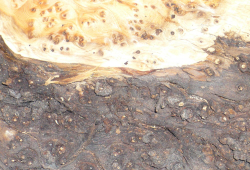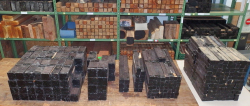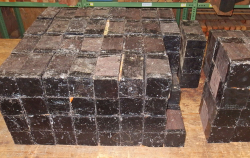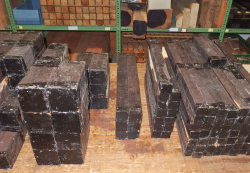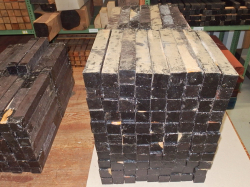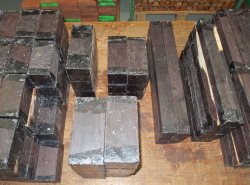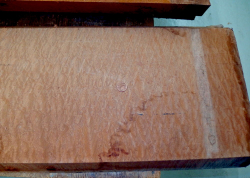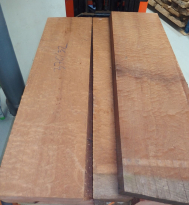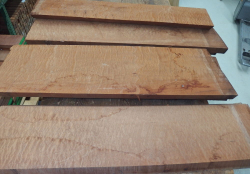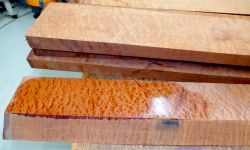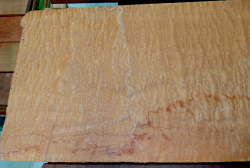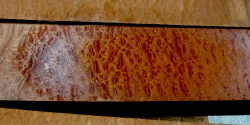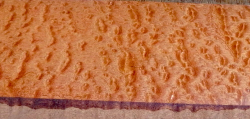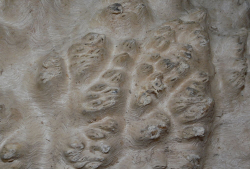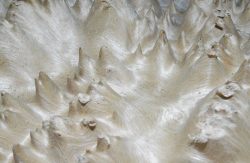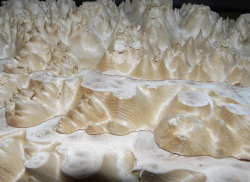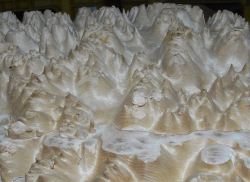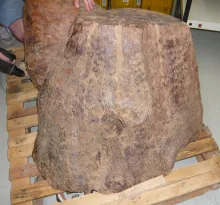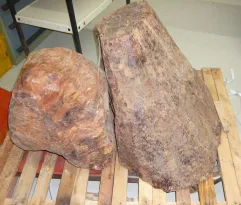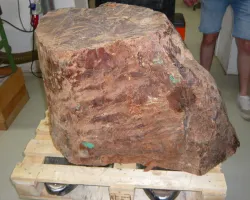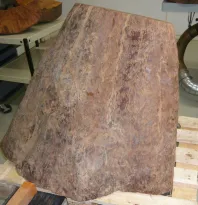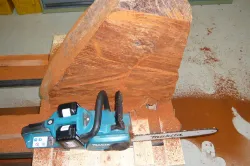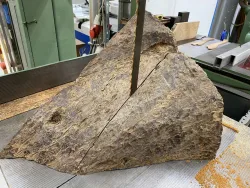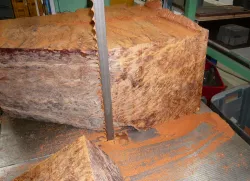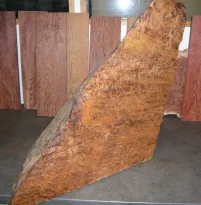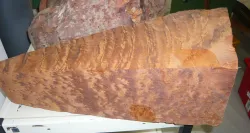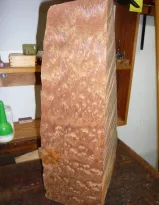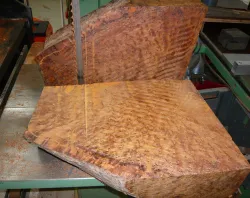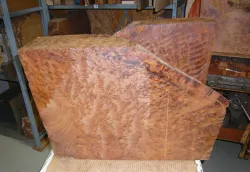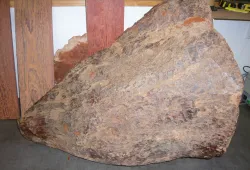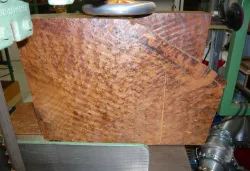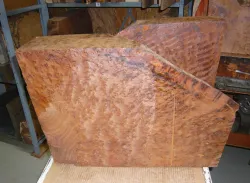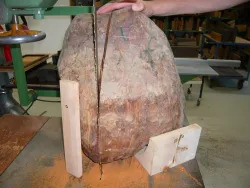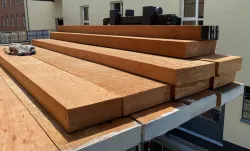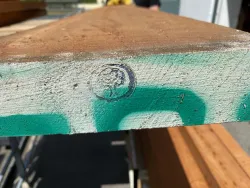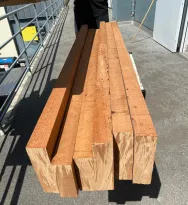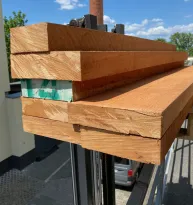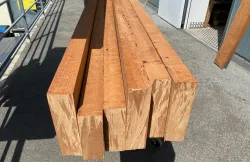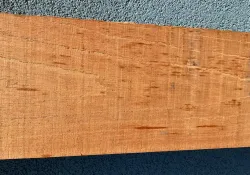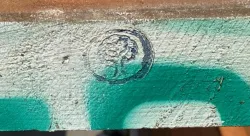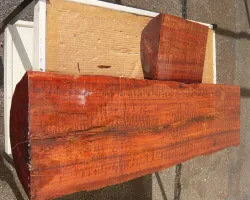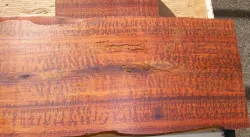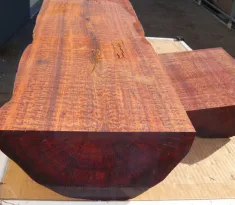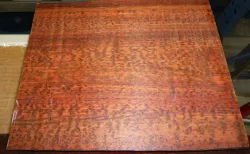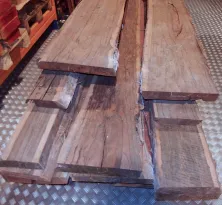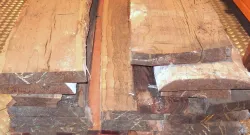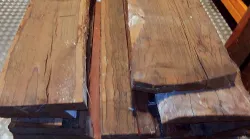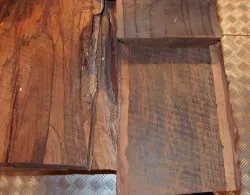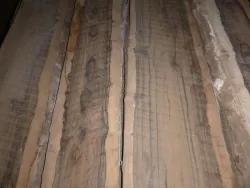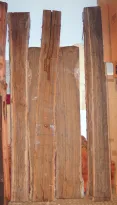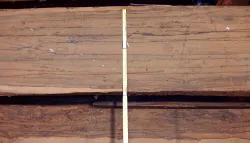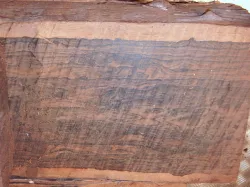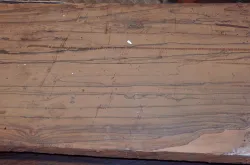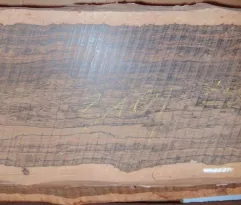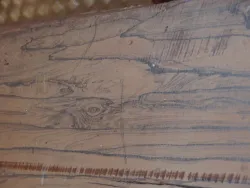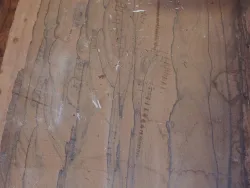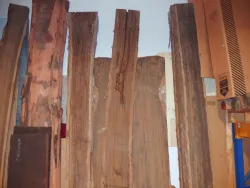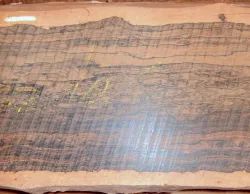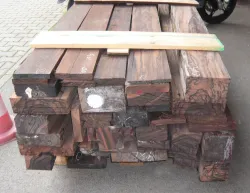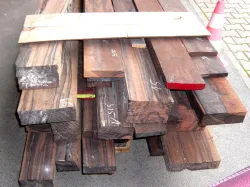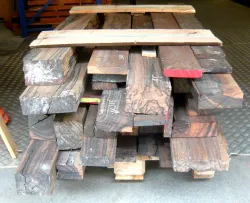Shipping country
Wood Species
News
In 2014 I was able to buy some slabs of a huge burl of elm wood, which is strangely called elm tree while alive, but after felling and sawing the wood is called Rüster here in German. These large slabs are a type of elm wood, which unfortunately I have not yet been able to classify more precisely: there are three types of native elm trees, the wood of which is probably quite different: The fluttering elm or white elm (Ulmus laevis) , the field elm (Ulmus minor, syn. Ulmus campestris) and the the wych elm or Scots elm (Ulmus glabra). Most elm burls are rather coarse-grained, develop strong cracks during drying and typically have large holes, bark and stone ingrowths and other defects that make it difficult to process. Not so these planks cut from a huge burl trunk, whose wood is finely grained, has very few defects, cracks and holes and is generally lighter in color than the red elm heartwood, which is quite dark. I suspect that this wood comes from the fluttering elm, but I am not sure. Expert advice on how to distinguish between these three species on the basis of their wood is very welcome here!
In the meantime, I bought other even larger burls, which turned out to be much more difficult wood. Cracks, bark and stone ingrowths, coarse structure, enormous warping during drying, the whole package of properties that are not appreciated in wood. And now back to 2014: at that time I was able to buy some slabs that came from this above-mentioned batch, and I didn't even realize how lucky I had been with the beautiful and very low-defect quality of this burl. And any sane person would hardly dare to hope that after such a long time, almost exactly ten years, the rest of the burl boards from 2014 would still be available. After a few phone calls, emails, photos and patience, I then realized that the rest of these magnificent burl slabs still existed in an airy attic and I was able to buy this batch for our company Edelholzverkauf. So now you can find plenty of supplies of this beautiful wood in our elm wood category and the supply for the next few years should be secured!
All these features are present in the thick slabs of wood that were revealed after sawing a yew burl and I must say that I am always amazed by so much beauty, fine grain, swirled and intertwined finest growth rings in this wood. The thick branch on the 5th photo gives an idea of how many annual rings this branch alone has; it has probably been growing for almost 100 years. Take a look at the pictures and I hope you can share my enthusiasm for this special precious wood!
The last photos show in detail the fine shoots under the thin bark of the yew and their appearance in the wood on the planed surfaces.
Sometimes purchases can take a whole year ... that's about how long it took until we were finally able to buy this rare batch of really old grenadilla or African blackwood scantlings for woodwind instruments.
For some years now, this wood has been very difficult to obtain and has long delivery times, and it needs to dry carefully for at least 5 - 10 years before it can be further processed into components for clarinets, oboes, flutes or bassoons.
This wood has been on the Cites list since 2017 and since then may only be traded with certificates of origin that serve to protect this valuable wood. As this wood only grows endemically in northern Mozambique and southern Tanzania, there are no alternative areas with these trees. In addition, violent clashes between the army and armed fighters have been taking place in this region for years, making legal exports even more problematic. Export ports were temporarily occupied by jihadists, all of which makes the procurement of good tonewood scantlings from Mozambique almost impossible, and instrument makers are forced to use substitute woods, which many musicians and instrument makers do not consider to be of equal quality.
After a long period of preparation and negotiations, we have now been able to purchase this small batch of old tonewood scantlings, CITES permits have been issued for them and our customers can now buy grenadilla that was imported around 8 years ago and has been stored in warehouse conditions ever since.
There are scantlings for piccolo flutes, clarinets, oboes and bassoons, many barrels, bells, upper and lower joints, tops and bottoms are amongst and there are certainly also formats for uilleann pipes and other bagpipes. You will find these offers in our Grenadilla or African blackwood category!
In France, the term pommelé has become firmly established, which can only be inadequately translated as tufted. In France, as in England, there are many very descriptive terms for such growth abnormalities, which are very rare and therefore traded at a high price. This mahogany from Africa is Sapeli (Entandophragma cylindricum) and it has a really stunningly beautiful special grain that looks three-dimensional and very haptic.
We are delighted to be able to offer our customers something from this special wood and individual pieces will gradually be added to our webshop!
These include: Goldfield, red Mallee, yellow Box, brown Mallee, red Morrel and others.
The saws are already moaning quietly, as they know what kind of rock-hard wood is coming their way. But so far, our carpenters and the special saws have managed every cut successfully.
And up close, the spiky beasts also look beautiful, you just have to get close enough to see the bizarre beauty of nature!
But as it is almost always the case when you buy such tubers: either they are cut open so that you can examine the quality and grain inside, and then the price is also determined. The other possibility is to buy such a tuber in salvage condition, i.e. not cut open at all, and thus take the high risk of pulling a long face after the first cut, because the inside of the burl may be rotten, full of holes, bumpy, cracked or poorly grained. Then, unfortunately, one has grabbed the sh..t deep for a lot of money.
In this case, however, the whole thing turned out well, the large tuber weighing approx. 120 kg was flawless through and through, perfectly grained and free of cracks. The even distribution of the fine eye grain is really very beautiful, there are hardly any ungrained areas, and as a result we are once again able to supply you with first-class thuja burl wood at fair prices at fair prices!
For a long time we have been selling cedro from south America and especially Brazil, better known to most users as Spanish cedar. The name is a reflection of the timber trade from the New World to Europe: Spanish vessels were the first to import this pleasant-smelling wood to Europe at the end of the 17th century. The wood, which despite its lightness has a high strength and at the same time smells so beguilingly good, was called cedar because of its fragrance, and since it was Spanish ships that imported the wood, yet the name Spanish cedar was established.
We sell Spanish cedar mostly for humidors in various shapes and sizes, from small humidors for only a few cigars to entire walk-in humidor rooms, often containing thousands of valuable cigars from the most diverse countries. In order to give these precious cigars the best possible protection against loss of aroma, drying out and thus loss of value, genuine Spanish cedar is the acknowledged best wood for storage with particularly good moisture management. But cedro is also the wood of choice for the neck of sophisticated guitars, especially for handcrafted one-off acoustic concert guitars: lightness combined with high bending stiffness and resonance make this wood an indispensable quality feature.
Now, due to a larger order, our stocks were running low and we were glad to be able to take a lot of Cedro of the very best and flawless quality into our tempered warehouse: Such quality is not always available, especially since for some time now this wood has been on the Cites list, meaning that only legal, certified wood with proof of origin may be traded.
Also for guitar builders we have again very beautiful Cedro blanks for guitar necks in stock, often with perfectly standing annual rings and in flawless quality.
Our stock is well filled again and we will gladly supply you with precise blanks in desired thicknesses, lengths and widths. You can find our cerdo items as always in this category, feel free to write us an email for a quote if we do not have your desired dimension in the webshop.
Anyone who has ever dealt with snakewood knows the challenge that this wood presents: It is probably the most expensive and difficult wood to work with because of its unpredictable characteristics.
A log that looks beautiful from the outside can turn into an expensive disaster after the first cut, usually through the heart of the log in the middle: It is never possible to predict whether the mottling that is visible from the outside, which the wood must have, can also be found on the inside. If you were lucky and the fine grain is also found inside, it is far from certain that the distribution of the specks is also reasonably uniform. Often there are very nicely grained areas that are next to almost no grained parts at all, and that greatly detracts from the appeal.
And then there's the matter of the legendary cracks: snakewood is particularly prone to cracking due to its extreme density and hardness (it weighs about 1300 kg/m3), and it's a real art to make the cuts so that these cracks don't affect the finished product. Since the price is so exorbitantly high, offcuts and waste must be avoided as much as possible.
The log shown here is one half of a whole log weighing over 100 kilos, and although someone was in Suriname to inspect the log, the first cut was not made until after the purchase, which is a high risk.
In this case, however, all was well and this particularly thick trunk exceeded my expectations: I haven't had a log of snakewood that is so beautifully and evenly grained with few cracks (yet) in certainly 10 years, but that can still change at any time during its further drying.
I have a particularly bad memory of a batch of Ziricote that I bought as logs, then had them cut up into planks to be dried down to workable moisture content in a kiln. At first, everything looked good, the planks had little to no cracks, and you look forward to the expected cuts you can make from the beautiful planks.
Reality then caught up with me at the sliding table saw where the wide planks were to be rough cut. When the longitudinal edges were trimmed, the world was still fine, but the first cross-sections for cutting to length revealed the whole catastrophe: the planks were crisscrossed on the inside with several cracks that severely limited their usability. There was real frustration, including a rather desperate outburst of anger...all the work, the money, the long wait, the patience until the wood was dry - all for nothing. Since then, my relationship with Ziricote has been very split. I still love the wood, there is perhaps no other wood besides Brazilian rosewood that can have such crazy, bizarre and psychedelic grain patterns, the dark brown color with the black sharply defined lines is something very special. However, my experience with the severe cracking of this wood has greatly dampened my enthusiasm and rarely led me to buy this expensive wood again in any appreciable quantity.
But as it often goes in life, many a disappointed love can flare up again when circumstances are favorable. And that is now the case with us, I was able to buy a nice batch of this wood, and this time, amazingly, all went well between me and the bitchy wood: rarely have I seen such beautiful, crack-free and best grained Ziricote, it is simply a great pleasure to cut this wood. There are some spectacular scantlings and boards with stunning grain posted in the store now (2023-02), and surely there will be far more in the future. I am pleased to be able to offer you such beautiful wood as this Zirikote!
Large blocks with almost 20 - 30 cm diameter are an absolute exception, they have veneer quality and are simply beautiful. Coming soon to this webshop!













